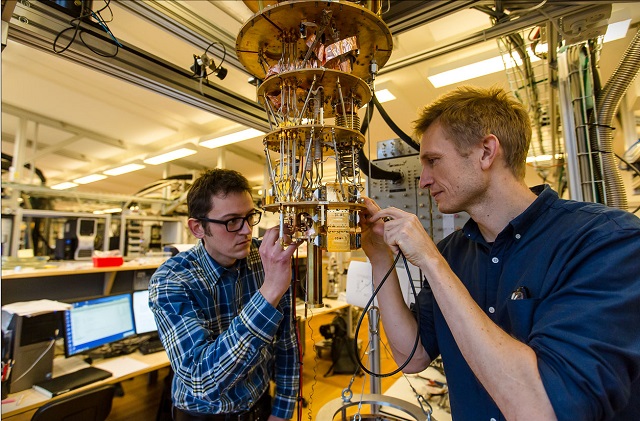 Thomas Sand Jespersen and Peter Krogstrup, here seen in the laboratorie at the Center for Quantum Devices, Niels Bohr Institute, where the research in nanowire crystals are taking place. The nanowire crystals may lie the foundation for future electronics, such as quantum computation and solar cells.
Thomas Sand Jespersen and Peter Krogstrup, here seen in the laboratorie at the Center for Quantum Devices, Niels Bohr Institute, where the research in nanowire crystals are taking place. The nanowire crystals may lie the foundation for future electronics, such as quantum computation and solar cells.
Researchers at the University of Copenhagen have developed a new type of superconducting ‘nanowire’ crystal that holds great promise for future semiconducting electronics. These crystals, on the atomic scale, fuse metallic and semiconducting materials.
At low temperatures, the new material that is made up of a metal and a semiconductor, demonstrates a unique superconducting property. This would enable it to play an important role in the process of developing future electronics. The way in which future electronic devices and computers will function will depend on the quality and development of very small electronic circuits.
Our new material was born as a hybrid between a semiconducting nanowire and its electronic contact. Thus we have invented a way to make a perfect transition between the nanowire and a superconductor. The superconductor in this case is aluminium. There is great potential in this.
Associate Professor Thomas Sand Jespersen
Jespersen, who has worked in the field for more than 10 years, ever since research into nanowire crystals has existed at the Nano-Science Center at the Niels Bohr Institute.
Many new electronic components, including solar cells and transistors are made using very thin nanocrystal threads which are also known as nanowires. When working with nanowires, a significant difficulty is encountered when attempting to create an effective transition between the nanowires and an external electrical contact. However, worldwide, researchers have only been able to culture the nanowires and the contacts together. The new approach involved in this study has led to significant improvement in the quality of the contact and its reproducibility.
The atoms sit in a perfectly ordered lattice in the nanowire crystal, not only in the semiconductor and the metal, but also in the transition between the two very different components, which is significant in itself. You could say that it is the ultimate limit to how perfect a transition one could imagine between a nanowire crystal and a contact. Of course this opens many opportunities to make new types of electronic components on the nanoscale and in particular, this means that we can study the electrical properties with much greater precision than before.
Assistant Professor Peter Krogstrup
The research group has published their study in Nature Materials, where they have described the excellent contact and its properties. Further, they have demonstrated the ability to produce a chip made up of billions of identical semiconductor-metal nanowire hybrids.
“We think that this new approach could ultimately form the basis for future superconducting electronics, and that is why the research into nanowires is interesting for the largest electronics companies”, says Thomas Sand Jespersen.
Professor Charles Marcus leads The Center for Quantum Devices, and Krogstrup and Jespersen are part of this center. Microsoft is also part of the research collaboration. The Lundbeck Foundation and the Carlsberg Foundation have provided support for this study.
References